| Tractor Safety |

|
 HOME
HOMETractor Safety


| 1. Rollover Protective Structure (RoPS). 2. Flashing amber light for towing on roads. 3. Rear tail and work lights. 4. Mudguards. 5. Side light. 6. Seat-belt. 7. Posture designed seat. 8. Manual over-ride power steering. 9. Maximum visibility. 10. Hazard warning decals. 11. Hydraulic power for heavy lifting. | 12.Three point hitch to prevent back-flipping. 13. Draw-bar located low to minimise back-flipping. 14. Protective PTO shaft cover. 15. PTO shield. 16. Controls conveniently located. 17. Skid-resistant platform and footrest. 18. Neutral start switch with safety interlock. 19. Shroud and shield for fan and alternator. 20. Weights for greater stability and traction. 21. Sun-shield to reduce risk of skin cancer. 22. Headlights. |
Tractors are the main cause of accidental deaths on farms. Over the years, many farmers, farm workers and others living on or visiting farms, have been killed or seriously injured falling from moving tractors, run over by tractors, or crushed when a tractor rolls sideways or backwards.
Danger! Falls from tractors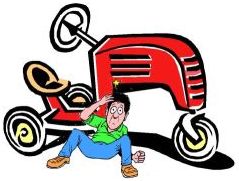 Danger! PTO shaft entranglement  Danger! Rearward Tractor Rollovers Danger! Rearward Tractor Rollovers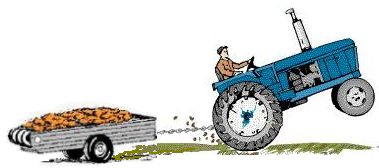  Danger! Sideways tractor rollovers Danger! Sideways tractor rollovers | The only safe place to sit on a tractor is in the driver's seat. An unexpected bump or quick turn can easily throw an extra rider from a tractor, resulting in serious injury. So, please do not ask for rides on tractors or other farm equipment. Most tractors, old or new, have a PTO shaft sticking out at the back. It is used to transfer power to another piece of machinery, such as a manure spreader. It spins at speeds of 9 to 15 rotations per second! Most tractors are equipped with a special shield to cover the PTO shaft. If this safety shield is missing, anyone who comes close to the rear of the tractor is in danger. If the rear wheels cannot rotate to move the tractor forward, the front will end rise up, and in less than a second, the tractor will turn over. Typical causes of a rearward tractor turnover are:
Sideways tractor rollovers can happen:
| |||
The following video is a supplement to the training session. | ||||
Principles of Defensive Farming | ||||
 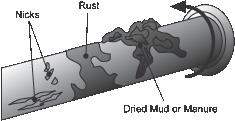  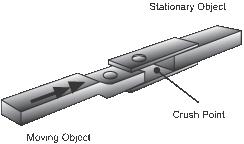 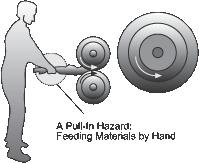 | Pinch Points: i.e. mangled or maimed points, are formed when two rotating objects move together and at least one of them moves in a cicle.
Crush Points: are created when two objects move toward other or one object moves toward a stationary object. For example, hitching tractors to implements creates a potential crush point.
Pull-in Points: mechanisms designed to take in crops or other materials for processing. They include combime headers, windrow pickups, and grinders. | |||
Make the changes
Here are some ways of improving tractor operator safety:
- Always mount and dismount on a tractor's left side - to avoid controls.
- Ensure an approved cab or roll-over protective structure (ROPS) is fitted.
- Fit and use a seatbelt on tractors with ROPS.
- If there is a risk from falling objects, fit a fall-on protective structure (FOPS).
- Wear hearing protection, and remember, not all tractor cabs are sound proof.
- Remove starter keys when tractors are not in use.
- Have an up-to-date maintenance schedule.
- Follow safe maintenance and jacking procedures.
- Ensure the operator is properly trained for each type of tractor work.
- Adjust the seat so all controls are safely and comfortably reached.
- Keep all guards in place, including the power take-off (PTO).
- Operate the self-starter from the operator position only.
- Drive at speeds slow enough to retain control over unexpected events.
- Reduce speed before turning or applying brakes.
- Watch out for ditches, logs, rocks, depressions and embankments.
- On steep slopes, without a trailed implement, reverse up for greater safety.
- Engage the clutch gently at all times, especially when going uphill or towing.
- Use as wide a wheel track as possible on hillsides and sloping ground.
- Descend slopes cautiously in low gear, using the motor as a brake.
- Never mount or dismount from a moving tractor.
- Ensure the park brake is on and operating effectively before dismounting.
- Take short breaks regularly when working long hours.
When towing implements
- Fit attachments according to the manufacturer's instructions.
- Always attach implements to the draw bar or the mounting points provided by the manufacturer.
- Never alter, modify or raise the height of the draw bar unless provided for by the manufacturer.
- Regularly check safety pins on towed lift-wing implements, to ensure they are not worn.
- Ensure all guards on towed implements are in place before operating.
- Never hitch above the centre line of the rear axle, around the axle housing or to the top link pin.
- Never adjust or work on implements while they are in motion.
- Never attach implements unless the PTO shaft is guarded.
- When parking, always lower the three point linkage and towed implement.
- Adjust the tractor seat for back support and comfort.
- When buying a tractor, ensure seating is safe and comfortable.
- Check seat height, seat depth, back rest height and angle, fore and aft movement, seat tilt, firm padding, partial pivoting (if you have to spend long periods looking behind you), and vibration-absorbing suspension.
- Dismount every hour or so, and spend 5 or 10 minutes doing something active.
- Plan for your next tractor to include suitably low steps, hand grips, adequate doorway and cab space, and a safe mounting platform.
- Dismount by climbing down - not jumping down - and use each provided foot and hand hold.
